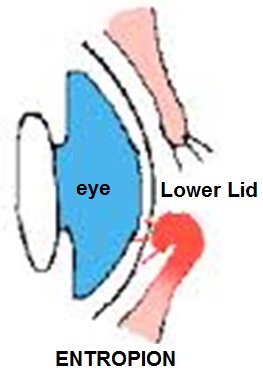Many conditions can impact the position of the eyelid relative to the eyeball. These malpositions can cause reduced vision as the eyelid may block vision or it may cause irritates the eye surface due to increased exposure and dryness.
TYPE
There are four basic eyelid malpositions:
- Drooping of upper eyelid (ptosis)
- Entropion (inturning of the eyelid)
- Ectropion (out turning of the eyelid)
- Retraction of the eyelid
PTOSIS – refer topic “ptosis”
ENTROPION
Entropion is an inversion of the eyelid. It will cause eyelashes to rub against the surface of the eye (cornea and conjunctiva). This frequently causes an irritation and redness to the eye and usually needs treatment, either medical or surgical intervention.
 |
There are four main types of ectropion:
- Involutional (senile)
Is the most common type and affects mainly the lower eyelid because the upper eyelid has a wider tarsus and is more stable. It is caused by a combination of age-related changes such as laxity of the eyelid and weakness of the lower eyelid muscle.
 |
- Cicatricial
o Is caused by severe scarring of the conjunctiva, which pulls the eyelid margin towards the globe.It may affect the lower or upper eyelid. The causes include cicatrizing conjunctivitis, chemical injury or burns to the eye.
 |
- Congenital
True congenital entropion is very rare. It is caused by improper development of the eyelid muscle insertion - Acute spastic
Is caused by spasm of the eyelid muscle (orbicularis) resulting in eye irritation and eyelid spasm.
The symptoms of the entropion include tearing, eye irritation, eye redness and discharge. Eye examination shows inturning of the eyelid, lashes rubbing the cornea, congestion of the conjunctiva and erosion of the cornea due to constant rubbing of the lashes on the cornea.
Entropion treatment can be divided into medical (temporary) and surgical (permanent). Medical treatment is frequent lubrication of the eye to reduce the eye irritation. The surgical treatment is determined by the type and severity of entropion.
ECTROPION
Ectropion is an outward turning of the eyelid. With aging, the eyelid becomes very lax and this can cause the eyelid to sag and turn outward. The dryness of the eye surface is irritating and can cause chronic red eyes. Ectropion commonly occurs in lower eyelid. This condition usually needs treatment, either medical or surgical treatment.
 |
There are four main types of entropion:
- Involutional (senile)
It has many features in common with involutional entropion. It commonly affects the lower eyelid of elderly patients. The aging changes responsible for ectropion are similar to entropion. It is characterised by eyelid laxity and weakness of eyelid muscle
 |
- Cicatricial
It is caused by scarring or contracture of skin and underlying tissue, pulling the eyelid away from the globe. Important causes include tumours, injury and burns of the eye.
 |
- Congenital
It is a rare bilateral condition which may occur in isolation or in association with blepharophimosis syndrome. - Paralytic
It is caused by facial nerve palsy.
 |
The symptoms of the ectropion include tearing, eye irritation, eye redness and discharge. Eye examination shows outward turning of the eyelid, congestion of the conjunctiva, erosion of the cornea caused by incomplete blinking to close the eyelids.
Treatment of ectropion can be divided into medical (temporary) and surgical (permanent). Medical treatment is frequent lubrication of the eye to reduce the eye irritation. The surgical treatment is determined by the type and severity of ectropion.
EYELID RETRACTION
Eyelid retraction is present when the upper eyelid is displaced superiorly or the lower eyelid inferiorly, exposing the sclera between the limbus and the eyelid margin. Lower eyelid retraction may also be a normal variant in patients with shallow orbits or certain genetic orbital or eyelid characteristics.
Eyelid retraction occurs when the muscle is overactive or inflammation and scarring causing it to tighten and pull the eyelid thus it will open more than normal. This frequently causes a surprised appearance and irritation of the eye surface because of dryness. It is frequently seen in patients with thyroid eye disease.
Other causes of eyelid retraction include post cosmetic surgery of the eyelid (such as lower eyelid blepharoplasty), eye muscle problem or a central nervous system lesion.
Eyelid retraction can be corrected surgically by several lengthening techniques.
 |
REFERENCES
- www.mei.org/eyelid-malposition
- Jack J. Kanski Clinical Ophthalmology: A systematic Approach 4th edition 1999
- Lelli GJ Jr, KazimM. Levator excursion as a predictor of both eyelid lag and lagophthamos in thyroid eye disease. Ophthal Plast Reconstr Surg 2010; 26(1):7-10.
- Meyer DR, Wobig JL. Detection of contralateral eyelid retraction associated with blepharoptosis. Ophthalmology. 1992;99(3): 366 – 375
- http://www.pfofflaserandeye.com
- https://www.google.com.my/search?q=entropion+and+ectropion
| Last Reviewed | : | 23 August 2019 |
| Writer | : | Dr. Rosniza bt. Ab. Razak |
| Accreditor | : | Dr. Shamala a/p Retnasabapathy |
| Reviewer | : | Dr. Rosniza bt. Ab. Razak |







